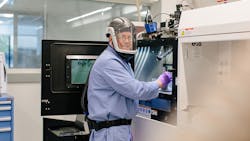This article appeared in Microwaves&RF. It is reprinted here with permission.
Emergency responders have been faced with finding enough face shields for protection during the COVID-19 coronavirus disaster. Fortunately, major defense contractors such as Raytheon Technologies have been able to contribute what they know in three-dimensional (3D) printing to form thousands of secure face shields for first responders and other emergency crew members. The company could combine additive manufacturing 3D printing machines from all around the world to meet the emergency needs.
“It was unprecedented to bring the entire corporation together to print one single file across multiple processes and materials using somewhere around 100 machines in less than two weeks,” said Jesse Boyer, fellow for additive manufacturing at Raytheon Technologies. “To ramp up to that volume that quickly is something that is touted using additive manufacturing, but rarely demonstrated. The opportunity was a great learning experience.”
Traditional manufacturing approaches cut a desired part from a piece of material, subtracting the material not required. In contrast, 3D printing or additive manufacturing builds a part by stacking layer upon layer as needed. The 3D approach can provide extremely efficient shapes and sizes that work well where space is at a premium, such as in aircraft. “The wild side is to continue to do that, to make very complex, yet optimized structures for areas we couldn’t normally do in a jet engine,” Boyer said. “We explore methods like bio-mimicry, by looking at the best nature has produced. Additive then reduces the constraints of conventional manufacturing and substantially increases our ability to optimize what we can manufacture going forward.”
When it came to the face shields, Paula Hay of Collins Aerospace, one of four businesses that form Raytheon Technologies, was able to apply 3D printing technology to the creation of the face shields. As Hay explained, “One of the big complaints about additive is, if you do something on two different machines, you get two different answers.” As Hay noted for the face shields for COVID-19, however, different machines should not make a difference: “When you have a good design and a good file, you get a repeatable product.” This emergency application shows a bright future for 3D printing in many aerospace and defense applications.
About the Author
Jack Browne
Contributing Editor
Jack Browne, Technical Contributor, has worked in technical publishing for over 30 years. He managed the content and production of three technical journals while at the American Institute of Physics, including Medical Physics and the Journal of Vacuum Science & Technology. He has been a Publisher and Editor for Penton Media, started the firm’s Wireless Symposium & Exhibition trade show in 1993, and currently serves as Technical Contributor for that company's Microwaves & RF magazine. Browne, who holds a BS in Mathematics from City College of New York and BA degrees in English and Philosophy from Fordham University, is a member of the IEEE.
